In 2022, Aiayu added repair workshops to its roster, teaching consumers how to mend and personalise their clothes. When the brand has surplus or damaged stock from previous seasons, it repairs and adapts them, selling them in-store and (since 2024) on its e-commerce site. “A few seasons ago, we had some sweaters produced in Nepal, but the linking was too tight in the neckline, so it broke when you pulled the sweater off. We replaced all the necks and mended them, so each one was different,” Høgh Heilmann says. The brand declined to share sales figures but says most of its one-of-a-kind drops have sold out. “What could have been waste has become hugely popular.”
New York via Mexico City: Campillo
Like Kartik Research, Mexico-based brand Campillo is leveraging the skill in its home country. For eponymous founder Patricio Campillo — who presented his first New York Fashion Week show in September — sustainability is about using natural materials and fortifying local supply chains.
Mexico City’s Patricio Campillo is trying to upskill and generate higher paid jobs for Mexican artisans.Photos: Campillo
Campillo only uses natural materials, the majority of which he sources from Mexico. Only silk and linen are unavailable locally and have to be sourced elsewhere (from Korea and Japan, respectively). The sourcing process is rife with contradictions and trade-offs, he says. “You can get recycled or certified organic materials, but if they are coming from the other side of the world, the carbon footprint will get messed up. And I’ve tried so many synthetic leather alternatives — including cactus and pineapple leather — but they tend to wear out much faster. What’s most sustainable? You never know if you’re making the right decision.” To try and make the materials he has available go further, Campillo is developing a tool box of techniques to manipulate them, including oxidation, vegetable dyeing and screen-printing.





